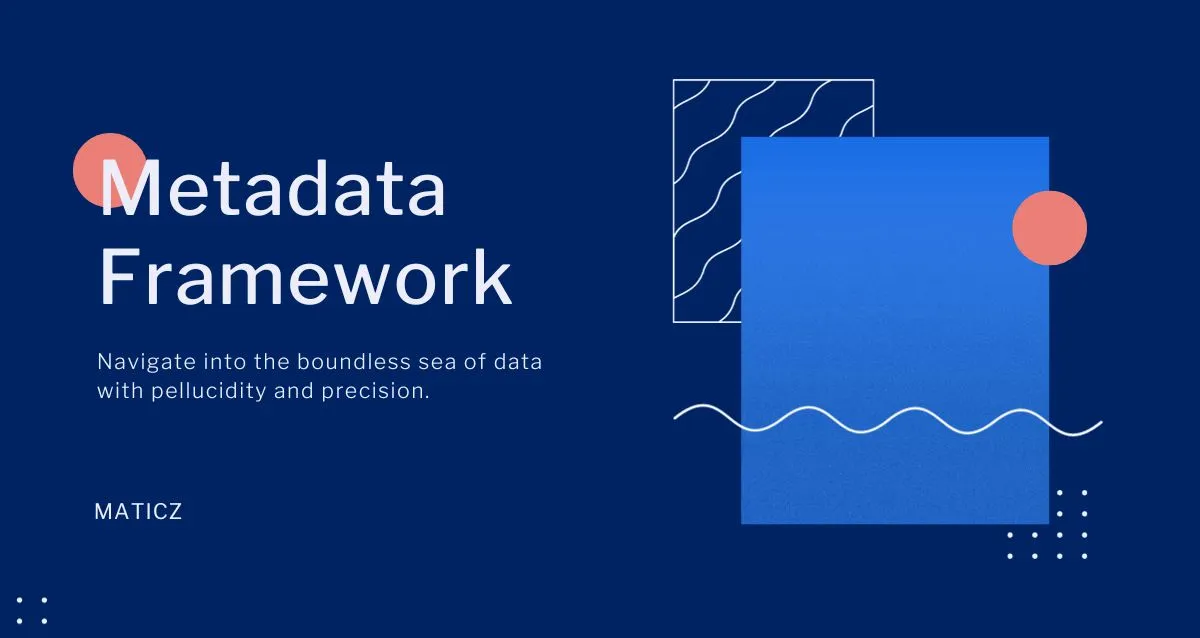Share Posts

What is Metadata Framework?
49
4110
103
The Metadata Framework helps as a reliable guide to traverse the data landscape with crystal-clear clarity. Let’s delve into the intricacies and feed our understanding of the importance that it holds in managing information
1) What is a Metadata Framework?
2) How Metadata Framework is Built?
3) Types Of Metadata Framework
4) Element Of Metadata Framework
5) Why Metadata Management Framework is Important?
6) Benefits Of Metadata Framework
7) Retrievable Future With Metadata Framework
What is Metadata Framework?
In the intricate landscape of data management, It is complicated to fetch the correct and required data when needed. While migrating through the vast sea of data, it is possible to lose any information if it’s not properly searched. That’s where the metadata framework comes into play.
Metadata Framework simply known as data about data, is a set of rules and guidelines on how information about the data is structured and organized in a specific context that includes how it should be described, labeled, and interrelated. With the framework, the world of metadata is similar to a library without a catalog, the information may just exist, but finding, analyzing, and utilizing it efficiently is a tedious task.
The primary purpose of the metadata framework is to set a common language for better understanding among the organization which prevents confusion and inefficiency. In between the chaos of the digital world, the metadata framework brings in an organized way ensuring that each information finds its perfect position.
How Metadata Framework is Built?
Building a metadata framework involves a systematic approach to defining the structure, organization, and management of metadata within a specific context, such as an organization or a project. Here are the general steps to build a metadata framework.
Define The Goal
The main objective of the company is to understand the requirements and the challenges faced by the organization. This improves the functionality of the organization prevents data quality issues and enhances understanding of the information between different departments.
Recognize The Stakeholder
Identify the stakeholders who will contribute to or be affected by the metadata framework. This includes the data managers (who manage the overall data), system administrators (responsible for the data quality), subject matter experts (IT Support), and the end-user (who utilizes the data).
Conduct the Data Inventory
Take a stock listing of the already existing metadata which includes what data is currently in use, where it is stored, when it is stored, how it’s used, who owns it, and how it’s managed. This step helps in the understanding of the current outlook of data and indicates the area for improvement.
Gather The Requirement
Interact with the stakeholders to collect the requirements for the metadata. Understand the information needs, use cases, and challenges faced by the different departments. This helps in achieving the requirements needed by the organization for improving the functional operations.
Define Metadata Types
Based on the gathered information, identify the type of metadata that is relevant to the organization. Find the specific information within the metadata and also mention what information needs to be stored.
Develop The Standards And Guidelines
Establish the standards for the data that is collected on how the data is structured and formatted. Define the guidelines for the data definition and data quality rules. Also, implement the metadata repository that governs the creation and maintenance of the data stored which results in consistency and coherence.
Develop Metadata Relationship And Schema
Determine how the metadata elements are related to each other to understand the dependencies and connections between various pieces. This process is to learn the context and interference. Develop a classification system that organizes the data and also provides a structured framework for how the data is categorized and labeled.
Implement Metadata Management Tools and Establish Governance
Implement the metadata management tool which supports the storage access and maintenance of the Metadata ensuring adherence to the standards. Define the governance policies to oversee the use of metadata framework, resolve the conflicts, and mainly stick to the standards.
Train And Educate
The training program is conducted to ensure that stakeholders will interact with the metadata framework ensuring the importance of the metadata on how to create, store, maintain, and access it for the specific task. This will improve the overall functionality of the organization.
Interactive Improvement
It is considered an evolving entity based on regular reviews and updates based on the feedback collected, changing requirements, and technological advancement. Continuous improvement ensures the framework remains relevant and effective.
Types Of Metadata Framework
There are several ways to classify metadata, but let’s focus on the main types of metadata.
Structural Metadata
It refers to the information that describes the relationship of the components within the document or data resources. It is like a map that exhibits how different piece of information is interconnected, structured, and arranged. It mainly focuses on the content and helps to manage the large volume of data.
Descriptive Metadata
Descriptive metadata is information that provides an answer to ‘what’ of the object. It helps to identify the location of the specific data within the database or other repository. It describes what the data is about and helps the users to understand the meaning of the content. It plays an important role in organizing, discovering, and managing the information by providing an overview.
Administrative Metadata
It is the metadata that provides the information about management, administration, and handling of data through the lifecycle. It supplies information about when and how was the data created, who can access the data, and what can be done with it. It holds the information about the creation and modification of the data and controls the access ensuring that the data is secured.
Technical Metadata
It provides information on detailed technical aspects of how it can be accessed, read, and maintained including particulars about data resources, their formats, structure, and the underlying technology used for processing, storage, and retrieval. It helps in preserving the data for future reference. It allows fetching the data based on the technical criteria.
Preservation Metadata
It is designed to provide information about the long-term preservation and management of the resources. The primary purpose is to record the ongoing access, authenticity, and integrity of the data resources ensuring the sustainability of the information.
Provenance Metadata
This type simply tells the story of the particular data including the origin, history, and chain of custody of a specific piece of data. A clear history of data enables the assessment of credibility and trust. It explains the journey from creation through modification to the current state.
Elements Of Metadata Framework
The Metadata Framework consists of the various elements that describe and provide information about the data which is needed to be labeled. Let's see some of the commonly used element
Title and identifier: A name and a unique identifier are assigned to the dataset.
Abstract: A brief description of the data labeled
Keywords: A tag that relates to the main topic of the data.
Creation date: Particular about the created date
Origin: Details about the source of the respective data
Data Lifecycle: Information about the creation date, modification process, and other history of the data.
Technical details: information comprising filesize, format, language, and encoding used
Rights: Information about the license governing the data and rights over the data
Contact information: contact details about the person or the entity associated with the data.
Statistics: informs about the download count and last accessed date.
Why Metadata Management Framework is Important?
The Metadata Management Framework is important for the organization handling a large volume of data and diverse information. It provides a constructive approach to collecting, organizing, and accessing the data effectively. Let’s discuss some of the reasons.
- It establishes the standardized method for creating and managing the data resulting in consistency and enhancing better data understanding with a clear description of data elements and the relationship between them.
- The consistent method contributes to improved data quantity and also helps in identifying and rectifying errors which ensures the reliability and trustworthiness of the data.
- It facilitates collaboration by creating a common language that is easily understood by the various departments ensuring that the team member is involved in the data-related activities and invariably uses the metadata.
- Metadata management ensures that the organization adheres to the security protocol, guidelines standards, and other data management regulations thus reducing the data retrieval process.
- A well-maintained data system supports better decision-making enabling the users to trust the metadata related to the dataset and therefore make more informed decisions about the analysis and interpretation.
- It supports interoperability which allows the exchange and integration of data across various diverse platforms or technologies thus resulting in the wider scope of business development.
- It minimizes the errors in the data process leading to cost savings by streamlining the workflow, improving efficiency, and reducing the resources used to rectify the data-related issues.
- It also supports future-proofing allowing the metadata to remain relevant in the system as the organization evolves and technology changes.
Benefits Of Metadata Framework
Metadata provides numerous advantages in various aspects of utilization and data management. Here are some key advantages.
Better Data Discovery
Metadata framework helps in data discovery by providing the appropriate description for the datasets thus helping the user to quickly locate the required data. It also supports real-time automation allowing the user to receive updated data thus increasing the data quality.
Standardization And Consistency
The dataset is standardized with definitions and descriptions to eliminate the error caused by the common terms. Title, languages, and other attributes are labeled by sticking to the schema to avoid inconsistencies.
Cost Effective
This data trend takes us toward a sustainable future by saving storage expenditure and reducing the redundancy of the data.
Refined Marketing Approach
Organization smartly uses the metadata to monitor the content usage of the datasets by tracking the customer's data reference through the system and collecting information about the customer’s preference which in turn increases the sales. An example of this is the ‘people who bought this also viewed’ section in almost every e-commerce website.
Data Governance And Adherence To The Guidelines
Following certain protocols can prevent compliance issues, data breaches, and cyber-attacks which lead to some serious problems like economic and even sometimes legal repercussions. Metadata ensures compliance with the regulations to implement data security. It also plays a vital role in data governance by constructing a standard approach to manage and control data.
Enhances Life Cycle Management
Metadata assists the data lifecycle from creation, modification, sharing, and deletion. This helps the organization control and manage data and reduce redundancy ensuring the data remains valuable throughout the lifecycle.
Increases The ROI
Understanding the data management, integration, collaboration, and proper usage of the available data helps the organization to maximize the Return on Investment (ROI) from their data assets.
Retrievable Future with Metadata Framework
Metadata framework plays an important role in how we handle a vast sea of data and face real-world issues with data-driven from the sea. They provide essential information required to traverse the enormous amount of data with clarity and utilize the wealth of the data in stock with us. The dynamic duo of Metadata Framework and Metadata Management Framework takes center stage in transforming the theoretical principle into strategies. In the era of big data and complexes, these frameworks help the organization derive insights and also provide a compass to navigate into the boundless sea of data with pellucidity and precision.
Related Articles:
Tap Into the Future
The latest insights, posts, and project updates - straight to your inbox.




